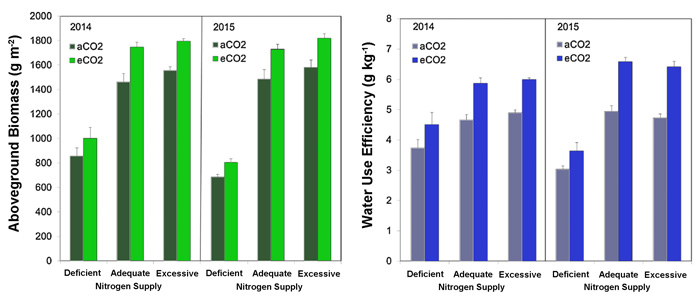| Tweet | Follow @co2science |
Paper Reviewed
Manderscheid, R., Dier, M., Erbs, M., Sickora, J. and Weigel, H.-J. 2018. Nitrogen supply - A determinant in water use efficiency of winter wheat grown under free air CO2 enrichment. Agricultural Water Management 210: 70-77.
In a field study that ran the course of two growing seasons, Manderscheid et al. (2018) examined the combined effects of elevated CO2 and nitrogen supply on winter wheat (Triticum aestivum, cv Batis) at the Thünen-Institute in Braunschweig, Germany, in 2014 and 2015.
The treatments studied included two atmospheric CO2 concentrations (ambient, at 393 ppm, or elevated, at 600 ppm) and three levels of soil nitrogen (deficient, adequate or excessive, accomplished by adding 40, 180 or 320 kg N ha-1, respectively, in 2014 and 35, 200 and 320 kg N ha-1 in 2015). Elevated CO2 levels were maintained using free-air CO2 enrichment (FACE) technology; but the CO2 enrichment was only applied during daylight hours from the three leaf stage until the end of grain filling (i.e., harvest) in each growing season. Irrigation was also applied, as needed, by the authors to maintain the soil water capacity within 50-90% of field capacity to prevent drought and nitrate leaching.
And what did the study reveal?
Nitrogen supply had a positive effect on the aboveground biomass of wheat (see Figure 1, left panel), but the effect was diminished when comparing the biomass difference between the excessive and adequate treatments and the adequate and deficient treatments. Elevated CO2 levels also improved wheat biomass, which stimulation was consistent among the three levels of nitrogen supply and across years; averaged across both growing seasons, the 207 ppm CO2 enrichment increased biomass production by 17%, 18% and 15% in the deficient, adequate and excessive nitrogen supply treatments, respectively.
Plant water use efficiency (WUE) was also strongly influenced by soil nitrogen levels and atmospheric CO2 enrichment (see Figure 1, right panel). Focusing on CO2, data averaged for both seasons indicated a CO2-induced increase in WUE of approximately 21% in the nitrogen-deficient treatment and 30% under both adequate and excessive soil nitrogen. Other calculations by the authors revealed that the positive effects of elevated CO2 on biomass and WUE resulted in an overall reduction of evapotranspiration by 2, 9 and 10 percent in the deficient, adequate and excessive soil nitrogen supply treatments, respectively. Consequently, Manderscheid et al. conclude that "the decrease of evapotranspiration suggests that seasonal water use of well-fertilized wheat will improve under elevated CO2."
Such findings as these are wonderful news, suggesting that elevated CO2 will increase wheat yields in the future while requiring less total water than at present to do so. And that is a win-win scenario for both wheat farmers and consumers!

Figure 1. Effects of atmospheric CO2 (aCO2 = 393 ppm; eCO2 = 600 ppm) and nitrogen supply (deficient, adequate or excessive) on above ground biomass production (left panel) and water use efficiency (right panel) between stem elongation and grain maturity during the growing season in 2014 and 2015. Source: Manderscheid et al. (2018).




